JQ Magazine: JQ&A with Web Entrepreneur Vanessa Villalobos
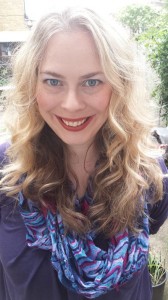
“If you create businesses based on your own experience and enthusiasms, you’ll never tire of them. Be sure to network with JETAA to stay in touch with people who are interested in Japan.” (Courtesy of Vanessa Villalobos)
By Rafael Villadiego (Nagasaki-ken, 2010-13) for JQ magazine. A member of JETAA New South Wales, Rafael is a collector of words on a journey still searching for a destination, who has a tendency to forget, we are all sometimes like the rain…
Like many JET alums, Vanessa Villalobos (Tochigi-ken, 2000-03) thoroughly enjoyed her time in Japan and was seeking a practical means to maintain that connection upon returning home. Seeking to recapture her experiences on the JET Program and maintain her Japanese language skills after returning to the United Kingdom, she founded the travel/lifestyle/culture site JapaneseLondon.com and the language exchange hub, IsshoniLondon.co.uk.
As an independent businesswoman and entrepreneur, she offers some advice to JQ readers seeking to pursue their own ventures and shares some insight into the trials and tribulations of language exchange. She also offers insider tips to discovering the hidden Japan in London along with the colorful contrasts between the two island nations, her thoughts on the recent vote for Scottish independence, and her take on the UK version of nattō.
How long did you spend on the JET Program and in which prefecture were you placed?
I was a “one-shot” ALT in Tochigi-shi for three years. Tochigi-ken is north of Tokyo and is famed for Nikko, strawberries and gyoza.
How did your time on JET influence the overall design and purpose of the websites?
Japan was endlessly fascinating to me, and I loved teaching Japanese learners of English. Thus, I chose to focus my business endeavors on connections between Japan and England.
IsshoniLondon.co.uk connects private tutors of English to Japanese learners of English. Most of the tutors are ex-JETs. In my intro video on the site, I explain how the kindness of friends and teachers in Japan allowed us teachers to develop an understanding and fondness for Japanese language and culture, and how we hope Japanese people will develop the same fondness of the UK. I am always looking for top-quality tutors, so please do get in touch if you’d like to work as a freelance tutor.
JapaneseLondon.com does what it says on the can! It’s a labour of love and is all about discovering Japanese things in London. It promotes and profiles the individuals, events and businesses that together make up “JapaneseLondon”! There is an events calendar, and I’ve just added a job board. Please do sign up to the newsletter on the site! JapaneseLondon.com can also connect you to a tutor of Japanese here in London!
Do you have any advice for JETs looking to setup similar initiatives in their hometowns?
Just get stuck in—and don’t give up. If you create businesses based on your own experience and enthusiasms, you’ll never tire of them. Staying power is important as it is sooo hard to build your own business from scratch. But it is deeply satisfying at the same time! Be sure to network with JETAA to stay in touch with people who are interested in Japan.
JQ Magazine Editor Interviewed by FCI News on X Japan at Madison Square Garden

JQ magazine editor Justin Tedaldi talks X Japan outside Madison Square Garden, Oct. 11, 2014. (Courtesy of FCI NY)
JQ magazine editor/Japanese Culture Examiner Justin Tedaldi (CIR Kobe-shi, 2001-02) was recently interviewed by Alex York of Fujisankei (FCI) News for commentary on X Japan’s debut performance at Madison Square Garden on Oct. 11.
The spectacular three-hour show (see JQ‘s review of the concert here) was X Japan’s first and only American concert in four years, and the first to retain the band’s signature full stage production outside of Japan. Check out the video here or click on the image for Justin’s comments, and read his exclusive interview with X Japan’s leader Yoshiki here.
Direct link: http://www.youtube.com/watch?v=yWptyvtYCXM#t=43
JQ Magazine: Film Review — ‘The Tale of the Princess Kaguya’
By Lyle Sylvander (Yokohama-shi, 2001-02) for JQ magazine. Lyle has completed a master’s program at the School of International and Public Affairs at Columbia University and has been writing for the JET Alumni Association of New York since 2004. He is also the goalkeeper for FC Japan, a New York City-based soccer team.
When one hears the name “Studio Ghibli,” the director Hayao Miyazaki immediately comes to mind. Starting with Nausicaä of the Valley of the Wind in 1984, Miyazaki has continually delivered hit after hit for the past 30 years, making him the most successful contemporary Japanese filmmaker (animated or otherwise). Moviegoers can be forgiven for not recognizing the name of Miyazaki’s partner and Ghibli co-founder Isao Takahata, who tends to operate behind the spotlight. But Takahata is an accomplished animator and filmmaker in his own right.
In the West, he is best known for the extraordinary Grave of the Fireflies (1988), a powerful anti-war epic about the firebombing of Kobe during the Second World War. Roger Ebert considered Fireflies one of the best war films ever made, and it certainly ranks among Studio Ghibli’s greatest efforts, elevating the standards of anime depicting serious subject matter. Takahata’s other films were successful in Japan but received limited distribution in the West—notably the ecologically minded Pom Poko (1994) and the comic strip-inspired comedy My Neighbors the Yamadas (1999). From this selection of titles, it is clear that Takahata can work in a variety of genres with different animation styles. Unlike Miyazaki, he delegates much of the animation work and does not have an immediately recognizable aesthetic.
Last year, both Miyazaki and Takahata announced their retirements. For his swan song, Miyazaki released the controversial The Wind Rises (read JQ’s review here), which managed to receive criticism from both the political left and the right in its treatment of the war. Takahata decided to end his career with a project that he conceived and abandoned 55 years ago: A feature film version of the tenth century folktale The Tale of the Bamboo Cutter. Both films were to be released simultaneously in a show of solidarity, but production delays resulted in a later distribution for Takahata’s film. The film became a big hit domestically, and is now receiving its U.S. release under the title The Tale of the Princess Kaguya in both subtitled and dubbed versions.

X Japan take a triumphant bow at Madison Square Garden, New York City, Oct. 11, 2014. (Vlad Baranenko)
By Vlad Baranenko (Saitama-ken, 2000-02) for JQ magazine. Vlad is an avid photographer. For his photo gallery of X Japan’s concert at MSG, click here.
On Oct. 11, Madison Square Garden was ignited by the amazing energy of the sensational Japanese rock group X Japan. Realizing a lifelong dream of its founding members—vocalist Toshi and superstar drummer/pianist Yoshiki—X Japan overcame years of behind-the-scenes drama to finally play the World’s Most Famous Arena, as one of the most successful Japanese music groups of all time brought down the house in NYC.
For the first time ever outside of their native Japan, X Japan culminated their dream to perform an all-immersive concert, armed with a full array of fireworks, pyrotechnics, confetti, and incredible light effects. According to Yoshiki in one of many heartfelt messages delivered to the crowd that night, never before their performance at MSG has the group invested so much to awe an overseas audience, which he said was being broadcast live to Japan and other Asian countries.
Playing to a nearly packed arena, the group that started with a dream of two four-year-old boys almost 45 years ago kicked off the show with a pyrotechnic bang, letting the excited audience rock hard to “Jade.” By creating an all-immersive experience for their concert goers, X Japan’s mix of rock and the classical genres appealed to the emotions of young and old attendees alike. For their second appearance in NYC after their legendary show at the now-defunct Roseland Ballroom in 2010, the band’s deep appreciation for their fans’ support rang loud when Yoshiki shared the story of the group’s history and ups and downs. The death of former members Hide and Taiji hit everyone in the group hard, and as Yoshiki spoke about his late friend Hide as still being part of the group, many in the audience shed a tear.
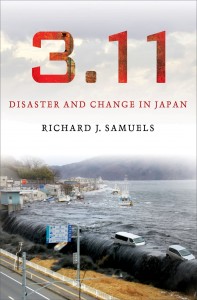
“Samuels draws from historical precedents and a rich and meticulously researched source material, as well as his extensive experience as a long-time observer and commentator on Japan, to produce a compelling and thought-provoking attempt to examine the true impact of the 3.11 disaster.” (Cornell University Press)
By Eden Law (Fukushima-ken, 2010-11) for JQ magazine. Eden currently serves on the JETAA New South Wales committee in Sydney, Australia as the online social media, webmaster and occasional editor. Got feedback? Leave a comment below.
The natural and man-made disaster of the 2011 Tohoku earthquake provoked an intense and visceral response from within and without, which saw an unprecedented level of cooperation between allies and between former enemies, and a united outpouring of human generosity and spirit globally. Little wonder then, that the usual cynical rhetoric was replaced with wholly credulous proclamations of a new age that could be an economic, technological, political and social rebirth of a nation.
“We expect a lot from crises,” author Richard J. Samuels notes in 3.11: Disaster and Change in Japan’s preface, and confesses to have himself been caught up in that same wave of optimism. What would the actual consequences be from the disaster? Would it bring a new era of “revival,” one of a number of slogans touted around Japan in the months following 3.11, or would the goodwill and its accompanying momentum evaporate in the face of reality that brings with it the problems of coping and dealing with a humanitarian disaster?
Samuels draws from historical precedents and a rich and meticulously researched source material, as well as his extensive experience as a long-time observer and commentator on Japan, to produce a compelling and thought-provoking attempt to examine the true impact of the 3.11 disaster. Starting with a description of the state of Japan around the time of the event, he describes a country in the economic doldrums, far from its position that it occupied decades earlier as an economic powerhouse that was the envy (and fear) of the developed world. Politically, Japan’s government had become a circus of ever-changing prime ministers, resulting in low public confidence in its leaders. Little wonder, then, that when the calamity of March 11th struck, the expectation and need for change seemed especially urgent and indeed, possible, more than at other time in recent Japanese history.
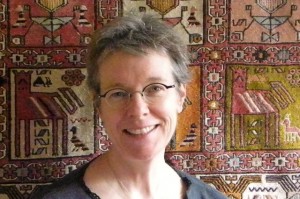
“Hopefully the lines between my actual experiences and pure fiction are seamless. When readers ask me, ‘Is this part true?’ they seem surprised by the answers. So that makes me happy—the fiction is believable and sometimes the outrageous is the truth.” (Courtesy of William Fraser)
By Rafael Villadiego (Nagasaki-ken, 2010-13) for JQ magazine. A member of JETAA New South Wales, Rafael is a collector of words on a journey still searching for a destination, who has a tendency to forget, we are all sometimes like the rain…
Laurie Fraser (Osaka-fu, 1997-98) is a writer and traveler who married a Kurd in Turkey in the 1990s. The experience inspired The Word Not Spoken, semi-autobiographical debut novel that blurs the line between reality and fiction, casting light on a tumultuous period in history through the eyes of those who experienced it firsthand.
The conflict between the PKK [Kurdistan Workers’ Party] and the Turkish Armed Forces has its roots in the First World War and continues to have repercussions for the region to this day. But beyond these grand struggles are the quiet moments in between: The ordinary challenges and trivial frustrations of everyday life, and the more overarching issues of culture and religion, which Fraser approaches with a genuine curiosity and gentle humor that forms the emotional core of her book.
An extensive traveler to a number of different countries across the globe, Fraser has experienced life in the broadest context before eventually finding her way “home.” Now a teacher and healer in Ottawa, JQ caught up with her to discuss the events of her life that inspired the novel and how they contrasted with her time on the JET Program.
What led you to first write this novel, and why did it take so long for the finished work to see light?
The scene where Ahmet and Leigh meet a group of destitute Kurdish refugees is exactly true, except that it happened in 1996, not 1995. I decided then to write a book and tell their story in a way that wasn’t “bad news.” At that time, my husband believed that the world would never hear about the Kurds if the PKK wasn’t setting off bombs. I recognized that as a Canadian, I had a right that he did not—the right to free speech.
I am a poet at heart, and I found a novel to be unwieldy to say the least. I had the poet’s need to touch every word over and over—so that slowed me down.
The Word Not Spoken was refused by countless publishers—I had a stack of rejection letters collected just in the year I was in Japan. It did well in a Canadian national writing contest in 2000, but only the winner was published. I was incapacitated with illness for a few years, but I eventually did a huge rewrite in 2010-11 with a professional editor. The manuscript did get better and better over the years, but it wasn’t until self-publishing became accessible and respected that I finally decided to go for it on my own.
I promised those refugees and my husband (who was killed in 1997) that I would publish their stories and really, it was a stone in my stomach for 18 years.
Kurdish House in Vancouver flew me out there (from Ottawa) to read to a large Kurdish audience this past spring. Afterwards, men and women came to talk to me: “I lived in one of those tents for four years.” “I was tortured 45 days.”
I have been haunted by the refugees I met living in those tents in 1996. I couldn’t imagine how any of them would have survived. These Vancouverites were an affirmation of life—some of them had made it! Some of them would have been children in 1996…and here they were! All I could say was, “I’m so glad you got here. I prayed for you.” And indeed, I wrote a book for them.
JQ Magazine: Book Review — ‘WA: The Essence of Japanese Design’

“WA is an excellent reminder that the analysis of everyday objects in our lives can be more insightful than we might first think, examining the roles of myriad mediums in Japanese daily life in ancient times to today including practical uses, religious ones, and political statements.” (Phaidon)
By Julio Perez Jr. (Kyoto-shi, 2011-13) for JQ magazine. A bibliophile, writer, translator and graduate from Columbia University, Julio is currently working at Ishikawa Prefecture’s New York office while seeking opportunities with publications in New York. Follow his enthusiasm for Japan, literature, and board gaming on his blog and Twitter @brittlejules.
Whether you like looking at furniture, crafts, art, and everything in between, in museums, magazines, or even Pinterest, you’re sure to appreciate the awe of a magical table, that from some angles is almost invisible, not to mention the rustic austerity of handmade materials for the Japanese tea ceremony and many other fascinating objects featured in WA: The Essence of Japanese Design. Throughout history, design and craftsmanship have had important roles in everyday life and practical uses, as well as in the arts and even in the political arena. WA explores the changing faces and development of Japanese design through the mediums themselves.
The book is divided into sections that include: Wood, Bamboo and Lacquer, Paper, Metal, Fabric and Textiles, Ceramic, and Synthetic/New Materials. Each section features a few dozen stunning photographs of objects, crafts, or even furniture, and a short essay that highlights pieces made from a particular material that, along with the photos, support its discussion about the development of that medium in Japan in a manner approachable for all readers. The contents of the book are written and selected by Rossella Menegazzo and Stefania Piotti, who are both scholars of East Asian arts and crafts, and they have successfully created a beautiful, approachable book on the subject.
WA explores the Japaneseness of Japanese design that has evolved throughout its history of ancient influences, from continental Asia and the Silk Road, through Japan’s periods of isolation, and continuing through today with its integration and innovation of Western design and cultural needs. WA is a very approachable book; the essays are not heavy with jargon and relate more to the pictures, which provides a very special and immediate connection to Japanese arts that would only be rivaled by holding the items themselves featured in the photos.
JQ Magazine: JQ&A with Mark Deyss of Marist Brothers International School in Kobe
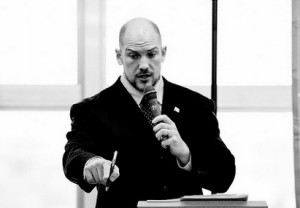
“When students do right, let them know about it and make sure to tell their parents, too. Show students that although you may have high expectations, you are fair and reasonable. Love what you teach and that excitement will transfer to students. These are some things that I found go into successful teaching.” (MBIS, courtesy of Flickr)
By Lyle Sylvander (Yokohama-shi, 2001-02) for JQ magazine. Lyle has completed a master’s program at the School of International and Public Affairs at Columbia University and has been writing for the JET Alumni Association of New York since 2004. He is also the goalkeeper for FC Japan, a New York City-based soccer team.
A native of Delmar, New York, Mark Deyss (Yokohama-shi, 2001-02) is a history and social studies teacher at Marist Brothers International School in Kobe, which has been a historic institution for the Kansai region’s pre-K through 12th children since 1951. Married with two young children, Mark is also a competitive bodybuilder in his spare time.
In this expansive interview, Mark spoke with JQ about how a visit to Iowa landed him his job, the unique benefits and challenges that go with teaching and living long-term in Japan, and some surprising misconceptions about bodybuilding.
What sparked your interest in Japan? Were you always interested growing up, or was it more of a curiosity thing?
I didn’t have a real interest in Japan per se. I was more interested in teaching in Indonesia (Bali, to be specific) or Thailand (Phuket). Both those places seemed pretty cool and exotic to a 22-year-old fresh out of college (SUNY Oswego). But what the hell does a 22-year-old know?! In the end, I backed away from those locations because from what I could tell, you needed to actually go to the place and start knocking on doors at language schools to find a job. That was a little too much adventure for me. A professor at my college mentioned AEON. I looked into it and it turned out that I could interview with them right in New York City. They gave me a contract to look over before I actually went to Japan and they seemed much more legitimate in general. That’s how my interest in Japan developed—as a conservative alternative to Bali.
Can you tell us about the conversation school you taught at in Japan before you joined JET?
I first came to Japan in September 1998 to work with AEON. Like most people who knew nothing about Japan, I requested to be located in Tokyo (in fairness to myself, I did actually know a couple of people in Tokyo, which is part of the reason for the request). AEON said they didn’t have anything in Tokyo open, but put me as close to Tokyo as possible—Hiratsuka City, in Kanagawa-ken. It worked out for the best, as most things in life do. I was with AEON for a year before taking a job (for a lot more money!) with another small eikaiwa outfit named Proto, which was actually run by a car parts manufacturer named Nippon Seiki (amongst other things they make dashboard and instrument panels for the “All-American” Harley Davidson and Chevrolet Corvette). Proto was located in Nagaoka, Niigata, surroundings that were much different than the urban congestion of Kanto. I was with Proto for about a year and a half before I came back to Kanagawa (Yokohama) for JET.
What did you do after JET?
I went to NYC to attend graduate school (education) at Queens College. Those years were indeed the hardest of my life, but my trials weren’t related to Queens College per se, more just being a scared young adult with an uncertain future and a tenuous present! Queens College served its purpose well and gave me the wonderful experience of living in Flushing, New York.
While attending the college, I taught at The Summit School, located in Jamaica, New York. It is a pretty good school for learning disabled and emotionally disturbed kids. I already had some experience working with that population of students before I went to Japan for the first time (summer job), so it was not an unfamiliar thing for me. That job served its purpose and provided me with enough money (barely enough!) to pay rent, eat three meals a day and get out of grad school debt free.
JQ Magazine: Book Review – ‘Colorless Tsukuru Tazaki and His Years of Pilgrimage’ by Haruki Murakami
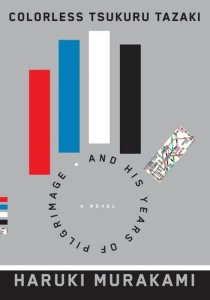
“Tsukuru Tazaki is more akin to a collection of related experiential pieces on existentialism rather than a straightforward story, which is why sometimes it can feel incomplete and unexplained. But there is a certain pleasure to be had from reading Murakami’s descriptive text, as he unhurriedly takes his time in building a backdrop by utilizing bits and pieces of asides and ephemera.” (Knopf)
By Eden Law (Fukushima-ken, 2010-11) for JQ magazine. Eden hails from the JETAA New South Wales chapter in Sydney, Australia, aging one hour at a time, his soul still empty, on the slow gentle slide to the eternal sleep of the grave. With the wind in his hair and a song in his heart, of course.
Haruki Murakami is a rare, superstar author who can engender the kind of excitement and anticipation more often seen with pop and movie idols. His latest novel, Colorless Tsukuru Tazaki and His Years of Pilgrimage, sold over a million copies in Japan in the first week, and overseas, the reception has been no less enthusiastic, with its release celebrated by midnight openings of bookstores with breathless fans queuing with anticipation.
Since its debut in English, the novel has topped the New York Times best sellers hardcover fiction list. As befitting such a book, it comes in a handsome dust jacket and cover designed by Chip Kidd, heavy with symbolism in blocked color bars and Japanese train routes peeking through plastic windows. Not all international covers for the book were created equally—check out this Tumblr gallery of all its international permutations, if you’re curious. It would seem that one doesn’t just read a Murakami novel; one experiences it.
I fully intended that last sentence to be facetious, but having finished the book, I’m not so sure I’m too far off the mark. In Tsukuru Tazaki, the author skillfully creates a world where characters are connected to each other by the most tenuous of relationships, gossamer-thin and fragile. For our eponymous protagonist, the most important relationship of his life—that with the only group of friends he has ever had—is suddenly and inexplicably severed, and he finds himself banished without explanation, causing a kind of spiritual trauma.
JQ Magazine: JQ&A with John Gaunter on ‘Sake Confidential’
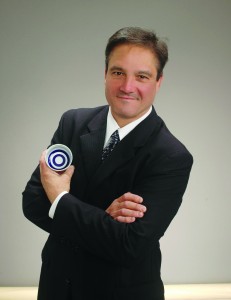
“Sake is so deep and varied that one could never stop talking about it. Every day is full of surprises. Not major ones, but usually surprises related to the attention to detail that goes into sake and the interesting stories behind it.” (Courtesy of John Gauntner)
By Eden Law (Fukushima-ken, 2010-11) for JQ magazine. Eden is a JETAA New South Wales committee member, who would like it to be known that if it wasn’t for getting involved with JETAA, he wouldn’t know what to do with his spare time after hours. JET: It’s like the Illuminati, except less about the world domination and more about the fun denomination. Got feedback on this article? Leave a comment below.
If ever there was a prize for most unexpected job opportunity spin-off from the JET Program, the career of John Gauntner (Kanagawa-ken, 1988-89) would be hard to beat, especially after a few rounds of nihonshu. A longtime resident of Kamakura and the world’s first (and only) non-Japanese to hold certification as both a Master of Sake Tasting and Sake Expert Assessor, Gauntner has come a long way since a drinking session with a buddy from The Japan Times led him to this series of fortunate events.
Proving that this beverage continues to be an infinite font of inspiration, Gauntner has recently added a new book to his growing stable of literary output, Sake Confidential: A Beyond-the-Basics Guide to Understanding, Tasting, Selection, and Enjoyment. In it, he covers all aspects of the precious drop: from what it is, how it is made, and how it is meant to be enjoyed (spoiler: any way you like it), to the inside story of its politics, marketing, and the industry itself. But this is no textbook: Like a true sake evangelist, Gauntner enlightens beginners and insiders alike, pairing clear and simple language with confidence and unabashed passion.
In this exclusive interview, Gauntner discusses the state of sake’s popularity in its own country and abroad, what it means being a non-Japanese sake evangelist with his unique qualifications, and what the future holds for him.
What was the reason behind writing this book, and who is its audience?
I wanted to show the depth and breadth of the sake world, to show it has as many avenues for exploration as wine does.
How is this book different from the others?
This book goes beyond the basics and more into depth about many interesting side topics of the sake world.
Is this book designed to replace or update your previous books?
No, it is intended to augment them. This one introduces less sake and is light on the basics,
What’s the market like for these books?
So far it is selling well, but ask me in two years!
What’s left to be said about sake? Are there any surprises left in the industry?
It is so deep and varied that one could never stop talking about it. Every day is full of surprises. Not major ones, but usually surprises related to the attention to detail that goes into sake and the interesting stories behind it.
JQ Magazine: Book Review — ‘Japan 365: A Drawing-A-Day Project’
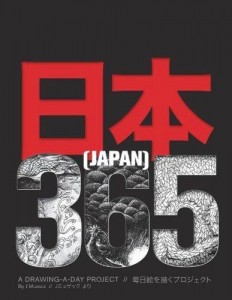
“Using nothing more than the simplest tools at hand to capture the moment, the artist establishes a tangible reality that lends an urgency and authenticity to the work that would not be possible in a more polished and composed form.” (J Muzacz)
By Rafael Villadiego (Nagasaki-ken, 2010-13) for JQ magazine. A member of JETAA New South Wales, Rafael is a collector of words on a journey still searching for a destination, who has a tendency to forget, we are all sometimes like the rain…
“If you attach a reason to an adventure, it ceases to be one.” –Uemura Naomi, noted Japanese mountain climber and adventurer.
「冒険に理由をつけると、冒険でなくなってしまう。」植村直己
There is something timeless and romantic about the idea of the wandering artist. Drifting aimlessly down untrodden roads and stumbling across hidden paths. Going wherever the wind might take them and all the while sketching random scenes from daily life, in all its raw and unfettered glory.
Japan 365: A Drawing-A-Day Project by current Melbourne resident J Muzacz (Kyoto-fu, 2010-12) is a drawing-a-day project that sets out to capture this sense of artistic wonder, in a fitting meditation on contemporary Japan. A black-and-white reproduction of sketches produced with nothing more than a simple ballpoint pen and notebook, the project sets aside all pretension and gaudy artifice and pares everything down to its barest essentials and fundamental simplicity. It is especially gratifying to see some pieces scribbled on the back of old pieces of paper or second-hand timetables. Using nothing more than the simplest tools at hand to capture the moment, the artist establishes a tangible reality that lends an urgency and authenticity to the work that would not be possible in a more polished and composed form.
While by no means an artist myself, there is something to be said about living the dream: An errant dreamer recording the world as they see it unfold. However, such whimsical fancy fails to fully appreciate the hard work and dedication inherent to such an undertaking. Consciously choosing to actively produce a completed work of art, every single day, for a solid year, is no mean feat. Having it ultimately culminate into such a hefty tome worthy of sitting comfortably on any coffee table or bookshelf, and feeling the solid weight of it all in your hands, is nothing short of remarkable. Artist/writer Muzacz and his supporters must be heartily commended for seeing it to fruition.
JQ Magazine: JQ&A with Trixie Cordova, Peace Boat US Volunteer Staff and World Up Education Director
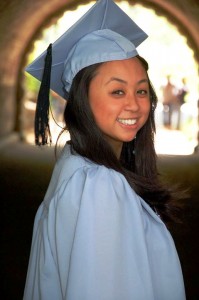
Trixie’s advice for new JETs: “Soak it in! Challenge yourself to try new things, explore the country, eat crazy foods, GET NAKED (at an onsen, anyway). Appreciate how different and preserved Japanese culture truly is, and don’t take your time abroad for granted. You were a chosen one, so embrace it!” (Courtesy of Trixie Cordova)
By Mark Flanigan (Nagasaki-ken, 2000-04) for JQ magazine. A member of the JET Alumni Association of New York’s board of directors, Mark is a program director at the Japan ICU Foundation in New York City and was also a Rotary Peace Fellow at ICU from 2010-12, during which time he volunteered for a tsunami relief mission in Ishinomaki after the terrible 3/11 tragedy. He can be contacted at mflanigan[at]jicuf.org.
Trixie Cordova (Shimane-ken, 2007-09) began volunteering with Peace Boat US in New York since last October. A civil society and non-profit organization, Peace Boat US works to promote peace, sustainable development, human rights and respect for the environment throughout the United States and the world through educational programs organized in partnership with the Japanese NGO Peace Boat, which carries out its main activities through a chartered passenger ship that travels the world on peace voyages.
At the same time, Cordova has served as education director for World Up, a non-profit organization based in Brooklyn that uses music, specifically hip-hop, and technology education to explore local and global issues affecting youth today. A graduate from Teachers College at Columbia University with a Master’s in International Educational Development, concentrating on Peace Education, Cordova has been quite active in JETAANY as well, serving on a career panel for recently returned JETs this past year. Prior to living and working in New York, she taught English in rural Japan for two years, where she first learned about Peace Boat while on the JET Program.
As a Peace Boat US volunteer, Cordova has been working toward creating opportunities for New York youth to participate in the Music and Art Peace Academy (MAPA) Program on board the ship. This summer, she will work closely with Unique Waters of World Up’s after-school music program “WU School” at the Brooklyn Community Arts and Media High School. Together they will lead music and leadership-based activities to promote cross-cultural understanding and to collaborate on a musical soundtrack to MAPA this summer.
JQ reached out to Cordova recently to ask her more about how her experiences in Japan and the Peace Boat-JET connection has led to this sea change in global education.
Thanks for taking the time to share your story, Trixie! Where and when were you placed on JET? Was it your first time in Japan?
Sure thing! I was an elementary and JHS ALT in Gotsu, Shimane, from 2007-09. Shimane’s claim to fame is that it isn’t famous—check out their unofficial mascot, Yoshida-kun, as proof! It was definitely my first time to Japan—I never studied the language or the culture before setting foot in Tokyo for JET orientation.
What was perhaps the biggest misconception you had about Japan before your experience on JET?
I honestly didn’t have very many preconceived notions about Japan, especially given that my decision to do JET was primarily just focused on moving abroad ANYWHERE, not necessarily because of any romanticized ideas I had about Japanese culture. Having said that, I think the biggest misconception I had about Japan was probably that the entire country had access to high-end technology and modern homes. I quickly realized that while that might be true in places like Tokyo, that was definitely not the case in rural Japan.
How many other JETs were in your town or local area?
In Gotsu, there were three ALTs—two JHS’s (dividing up the 10 elementary schools and four JHS), and one HS. I believe there was also a CIR, but ours was from China, and never really participated in JET-related events from what I can recall.
Gotsu was about 20-25 minutes from Hamada, where even more JETs lived! So we’d often go to visit Hamada, especially for sushi Thursdays at Sushizou!
JQ Magazine: Book Review — ‘Year Zero: A History of 1945’

“Though so many of the complexities of World War II and ensuing changes can not easily be summarized, Buruma’s analysis of 1945 provides several enlightening answers that begin to answer the question of how and to what degree a sense of normalcy is achieved after destruction.” (Penguin Press)
By Sheila Burt (Toyama-ken, 2010-12) for JQ magazine. Sheila is a scientific writer at the Center for Bionic Medicine at the Rehabilitation Institute of Chicago. Read more of her writing at her blog.
Consider the following historic events: the bombings of Dresden begin; Franklin D. Roosevelt dies after serving 12 years as president; the B-29 bomber Enola Gay drops “Little Boy” on Hiroshima followed days later by “Fat Man” on Nagasaki, resulting in hundreds of thousands of deaths, unprecedented instant destruction, and long-lasting illnesses caused by radiation exposure; after six long, bloody years, the Second World War finally ends.
Now consider that all of these events took place in 1945.
Following these milestones in the span of only a few months, how could countries so deeply entrenched in World War II return to any sense of normalcy? How do you rebuild a broken nation?
Author and journalist Ian Buruma explores these questions and postwar disorder in his latest book, Year Zero: A History of 1945.
Writing about a single year (or several months within a single year) is not new—among a few other examples, Bill Bryson recently covered the summer of 1927 in One Summer: America, 1927; in 2010; cultural critic Fred Kaplan analyzed the significance of 1959 in his book 1959: The Year Everything Changed; and in 2005, Mark Kurlansky declared 1968 as The Year that Rocked the World.
For Buruma, a Luce Professor of Democracy, Human Rights and Journalism at Bard College and the author of several books, including the novel The China Lover, 1945 may not be more significant than other years but one of the most groundbreaking for transformations. Rather than focusing on the postwar efforts of a single country, Buruma looks at the countries destroyed or nearly destroyed by the ferocity of World War II, specifically narrowing in on the postwar chaos and change in Europe and Japan. “How did the world emerge from the wreckage? What happens when millions are starving, or bent on bloody revenge?” he asks in the prologue.
JQ Magazine: Manga Review — ‘Showa 1939-1944: A History of Japan’
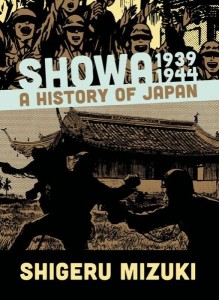
“Showa is an enjoyable book to read, and this volume in particular will appeal to those interested in World War II and comprehensible narratives of the political and military intrigue of the time.” (Drawn and Quarterly)
By Julio Perez Jr. (Kyoto-shi, 2011-13) for JQ magazine. A bibliophile, writer, translator, and graduate from Columbia University, Julio is currently working at Ishikawa Prefecture’s New York office while seeking opportunities with publications in New York. Follow his enthusiasm for Japan, literature, and board gaming on his blog and Twitter @brittlejules.
School might be out, but that doesn’t mean your educational summer reading can’t be fun. Welcome to part two of Shigeru Mizuki’s manga history of Japan during the Showa period! If you’re just tuning in or need a refresher, check out JQ’s review of the first book, Showa 1926-1939: A History of Japan. This series is translated beautifully in English by none other than JET alum Zack Davisson (Nara-ken, 2001-04; Osaka-shi, 2004-06) and published in North America by Drawn and Quarterly.
Illustrious manga artist Mizuki continues his retelling of the Showa period through his mouthpiece character Nezumi-Otoko (sometimes translated as Rat Man) of GeGeGe no Kitaro fame, and in this section includes events you have no doubt heard of such as the attack on Pearl Harbor and the Battle of Midway as well as ones you probably have not such as the Japanese campaign in the Dutch East Indies and the Battle of the Coral Sea, the first true incident of carrier warfare and air-to-air combat.
Mizuki also inserts his own autobiographical story into narrative, providing both a macro historical view and micro personal view of the war. As established in the previous volume, he has portrayed himself in a pretty poor light from the get-go, a good for nothing son that is too lazy to hold a job, can’t properly attend any school, and only seems to have a strong interest in eating as much food as possible. But the humble and comical portrayal of himself should be taken with a grain of salt, as Mizuki points out himself, in this era, “If we had a little food in our bellies, it was considered a blessing….We didn’t think about the future because we didn’t have one. Hard times at home were just the tip of the iceberg. After that there was the army, where all your future holds is an unmarked grave on a godforsaken island.”
JQ Magazine: JQ&A with Harry Hill, Chairman of CULCON
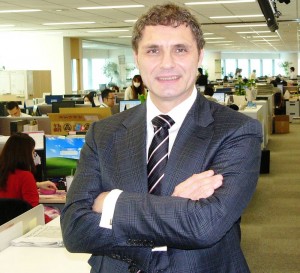
“My advice to the JETs is, don’t be afraid to take center stage and be memorable (of course in a respectful way), because these seemingly random relationships or encounters can be the source of great opportunity.” (Courtesy of Culcon.jusfc.gov)
By Alexis Agliano Sanborn (Shimane-ken, 2009-11) for JQ magazine. Alexis is a graduate of Harvard University’s Regional Studies—East Asia (RSEA) program, and currently works as an executive assistant at Asia Society in New York City.
As a martial artist, Monbusho Fellow, JET, consultant and CEO, there seems little that Harry Hill (Gifu-ken CIR, 1987-88) has not done or experienced when it comes to U.S.-Japan relations.
Now, Hill can add another feather to his cap: last February, the Japan-U.S. Friendship Commission and CULCON (the Conference on Cultural and Educational Interchange) in Washington, D.C. appointed him has their new chairman. For those familiar with Hill and his history, this appointment comes as no surprise: Hill knows Japan as intimately as he knows America. He began his career there as a Monbusho English Fellow in the mid-’80s and then served as a JET in Gifu Prefecture, experiences that helped him to tap into hitherto unexplored entrepreneurial sectors, in particular sports-related infomercials.
Since 2006, his company, Oak Lawn Marketing has been the largest infomercial brand in Japan. If you’ve seen Billy’s Bootcamp advertised there, you have Hill to thank for. Now back stateside, Hill uses his broad background in education, culture, business and non-profits to further strengthen interpersonal understanding between the U.S. and Japan. JQ caught up with Hill at his new digs—asking about life, opportunities and the risks that inevitably lead to his success.
Could you explain your background with Japan?
I developed a passion for martial arts, budo, and Shorjinji Kempo, in particular, during my time at college. This passion creates a curiosity and interest in Japan. During the summer of my sophomore year, I spent several weeks imagining my future. One of the books that influenced me at the time was Japan as Number One by Ezra Vogel. Looking around my immediate peers and acquaintances, I knew very few people who knew about Japan or could be considered Japan experts. Yet, many smart and respectable people were stating that Japan and Asia was the next land of opportunity. So I decided to start Japanese language training in my junior year with the intent of finding opportunity in Japan.
How did your time as a Monbusho English Fellow and JET lead to a career as an entrepreneur?
I was an MEF in Gifu Prefecture from 1985-1987 and the first CIR in Gifu during the first year of the JET Program from 1987-1988. As an MEF, I worked at both the kencho and kyoiku center. At the kyoiku center I helped put together teacher training programs for English teachers. In my two years in Gifu, I probably met and helped with training probably almost every junior high school or high school teacher in Gifu. I was also essentially a one-shot teacher. During my two year stint, I visited something like 230 of about 240 junior high schools and high schools, hence my job was more of a cultural ambassador who offered exposure to the English language and U.S. culture.
In 1988, Gifu hosted a regional exposition “Mirahaiku.” Since I also had a desk at the kencho, I was asked by the general affairs division to make the English name for the expo, which I named “Future Watch ’88.” The English name received a significant amount of press coverage, more from local media and to a lesser extent English language media, but inspired the organizers that the expo should have an international flavor. As a CIR from 1987-1988, some of my main responsibilities was to work for the planning organization for the expo, which was a hybrid of individuals seconded from both business and government. The expo was a great success, and the network of business leaders and government leaders with whom I worked side by side gave me the confidence that I could do business and open doors if I started my own business.


